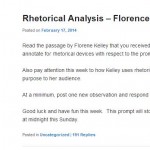Summary
This lesson engages rhetoric and composition students in weekly analytical discussions about the nature of rhetoric and argument in society. Each week, one HS’s students and their peers at another HS are presented with a text or an issue in society. For one week, they discuss the rhetorical implications of the text, design and defend arguments, and ultimately engage in discourse centered on the practices and rationales of contemporary rhetoric use in society.
WordPress blog website: http://blogs.henrico.k12.va.us/aplanguage2/
TIPC Ratings
Students must gather and share evidence in response to an open-ended writing prompt not unlike ones that students will see on the AP Language and Composition exam and in college. While reading peer-generated responses on the blog, students will synthesize information to use as evidence to support their own assertions in response to released AP prompts.
While the digital tool to foster student collaboration is fixed in a WordPress blog, students are not limited by time or geographical constraints which enables students from different schools to work together on a single authentic task. Ultimately, student may reflect on their own analyses with their peers in order to improve their writing in future analytical and argumentative tasks.
By nature, AP Language and Composition prompts are very open-ended and students must practice the rhetorical canons of invention and arrangement to determine the best approaches to address these prompts. In this collaborative blog, students encouraged one another to dig below the surface level in order to analyze not only what a text says, but more importantly how it says it and what effect it has on the reader. In doing so, students learn how to write more persuasively in their own argumentative essays by modeling what works well for professional writers.
There are many ways to effectively address AP Language and Composition writing prompts, but only those that demonstrate innovative thinking and careful composition warrant reading. The only way to ensure that writing warrants reading is to take risks to move the reader in the direction you want them to follow. This is tough for students to do without extensive practice, which this collaborative blog provides for students.





